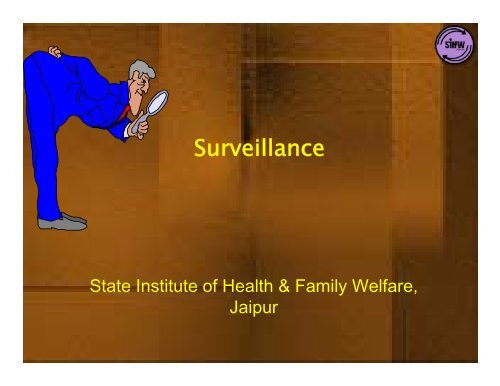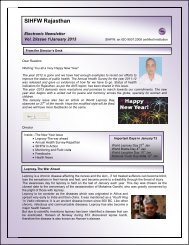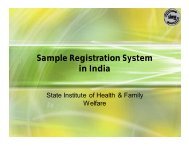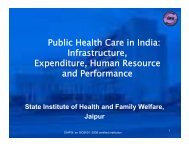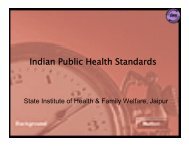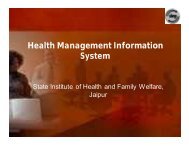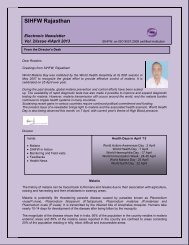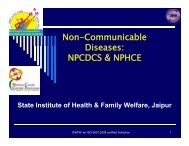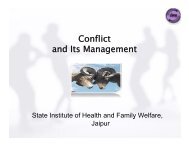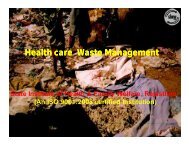Surveillance - SIHFW Rajasthan
Surveillance - SIHFW Rajasthan
Surveillance - SIHFW Rajasthan
Create successful ePaper yourself
Turn your PDF publications into a flip-book with our unique Google optimized e-Paper software.
<strong>Surveillance</strong>State Institute of Health & Family Welfare,Jaipur
Public Health ApproachRisk FactorIdentification:What is thecause?<strong>Surveillance</strong>:Whatis theproblem?InterventionEvaluation:Whatworks?Implementation:tiHow do youdo it?Problem <strong>SIHFW</strong>: an ISO 9001: 2008 certified institutionResponse2
<strong>Surveillance</strong>Information for Action<strong>Surveillance</strong> is the bridge between what wethink is happening and What actually ishappening<strong>SIHFW</strong>: an ISO 9001: 2008 certified institution3
<strong>Surveillance</strong> ?“a system of close, continuous observationof all aspects of theoccurrence & distribution of a diseasethrough systematicCollection,Tabulation,Analysis andDissemination (Timely) of all relevantdata pertaining to that Disease/event” .Descriptive (purposeful)Action (Public health policy)<strong>SIHFW</strong>: an ISO 9001: 2008 certified institution4
Purpose:General-Reducing mortality/ morbiditythrough timely prevention & controlSpecific-‣Understanding gproblemNHD,Magnitude,Trend‣Define priorities‣Decide objectives‣Determine strategies‣Evaluate control/ prevention‣Suggest t further research<strong>SIHFW</strong>: an ISO 9001: 2008 certified institution5
<strong>Surveillance</strong> Helps in:• Understanding Natural History• Deciding levels of existence ofdisease• Explaining changes in pattern withtime• Identifying Changes in agentcharacteristics• Measuring efficacy of control measure• Forecasting trends<strong>SIHFW</strong>: an ISO 9001: 2008 certified institution6
Uses of Public Health <strong>Surveillance</strong>• Estimate magnitude of the problem• Determine geographic distribution ib ti of illness• Portray the natural history of a disease• Detect epidemics/define a problem• Generate hypotheses, stimulate research• Evaluate control measures• Monitor changes in infectious agents• Detect changes in health practices• Facilitate planning<strong>SIHFW</strong>: an ISO 9001: 2008 certified institution7
‣ Routine‣ SentinelTypes:• Active (agency solicited)• Passive (provider initiated)• Reporting by specified units from definedarea• Denominator absent‣ Focused (Situation ti / Process / Area)• Case/outbreak investigations• Special surveys-Nutritional surveillance<strong>SIHFW</strong>: an ISO 9001: 2008 certified institution8
Routine <strong>Surveillance</strong>• Through Out Patient Dept. of Healthfacilities (Passive) Wait & See who reportswhat• Field surveys (Active) Go & Get Data/InformationIssues-Representative?Home treatment?Number of Health FacilitiesreportingCompleteness of reporting<strong>SIHFW</strong>: an ISO 9001: 2008 certified institution9
Passive• Simple• Less burdensome• Inexpensive• May not be representative• May fail to identify outbreaks<strong>SIHFW</strong>: an ISO 9001: 2008 certified institution10
Active• Assures complete reporting• Can be used with specific investigations• Can be done for brief periods• Requires skilled personnel• May be perceived as invasive• Expensive<strong>SIHFW</strong>: an ISO 9001: 2008 certified institution11
Sentinel <strong>Surveillance</strong>Monitoring of key health events throughsentinel:– Sites– Events– Providers– Vectors/animals<strong>SIHFW</strong>: an ISO 9001: 2008 certified institution12
Sentinel <strong>Surveillance</strong>• Reporting of health events by selected Units/Professionals representing a geographic area• Could be active or Passive• Only a small number of units selected• Selected units report all cases for a specific time period• Reports include additional information• Easier to maintain Quality & Regularity• Denominator absent• Data collected are Not representative &NO generalization<strong>SIHFW</strong>: an ISO 9001: 2008 certified institution13
Good <strong>Surveillance</strong> System:• Simplicityeaseof operation- minimum paper worksimple definitionsusing existing system• Flexibility• Acceptability• Sensitivity• Predictive value• Representative• Timeliness• Regularity• Data quality-complete/reliable/accurate• Cost-effectiveness<strong>SIHFW</strong>: an ISO 9001: 2008 certified institution14
Initiating a <strong>Surveillance</strong> SystemActivities:iti• Choose a disease that has provedcontrol measures available• Define how data collected shall beused• Set a standard case definition• Use existing system• Visit those who supply Data• Develop a data base• Develop a regular reporting system fordistribution (Feed back)<strong>SIHFW</strong>: an ISO 9001: 2008 certified institution15
Disease Selection for <strong>Surveillance</strong>Eligibility ibilit Criteria:i‣ Public Health problem (Quantitative BOD)‣ Impact• Clinical spectrum (Severity)• Mortality‣ Communicability (Epidemic potential)‣ Preventability (in terms of feasibility & cost)‣ Risk perception• Global health organizations• National authority•NGO• People‣ Political pressure<strong>SIHFW</strong>: an ISO 9001: 2008 certified institution16
Prerequisites of an Effective<strong>Surveillance</strong> System‣ Standard case definition‣ Enumeration of Reporting units‣ System For Disease <strong>Surveillance</strong>• Notifiable disease reporting System• Laboratory based surveillance• Hospital based surveillance• Population based surveillance<strong>SIHFW</strong>: an ISO 9001: 2008 certified institution17
Standard Case Definition‣ May not necessarily be the same aswhat clinician perceives‣ Depends on-• Severity• Certainty of Diagnosis– Confirmed– Probable– Possible– Suspect– Non-case• Purpose– Sensitivity– Specificity<strong>SIHFW</strong>: an ISO 9001: 2008 certified institution18
Systems of Disease <strong>Surveillance</strong>‣ Notifiable disease reporting System• Morbidity• Mortality• Case investigation• Epidemic i reporting• Field investigation• Drug and Biological use‣ Laboratory based surveillance‣ Hospital based surveillance‣ Population based surveillance• Surveys• Services<strong>SIHFW</strong>: an ISO 9001: 2008 certified institution19
Sources of <strong>Surveillance</strong> Data• Mortality• Morbidity• Case reports• Epidemic reporting• Epidemic field investigations• Laboratory reporting• Surveys• Vector distribution studies• Biologics & drug distribution• Demographic & environmental data• News media<strong>SIHFW</strong>: an ISO 9001: 2008 certified institution20
Choice of Source Depends On• Disease• Method used for identifying disease• Program goals• Resources-personnel/material• Population involved• Characteristics of disease occurrence<strong>SIHFW</strong>: an ISO 9001: 2008 certified institution21
<strong>Surveillance</strong> Processes:• Routine surveillance• Reporting• Motivation• Proceduralsimplicity• Case definition• Active reporting• Sentinel physicianreporting• Lab. <strong>Surveillance</strong>• Hospital surveillance• Absenteeismsurveillance• Special surveillance• Data analysis (time,place, person)• Reports andevaluation<strong>SIHFW</strong>: an ISO 9001: 2008 certified institution22
Diseases Under NPSCD #• Acute Flaccid Paralysis • Malaria(AFP)• Measles• HIV/AIDS• Meningitis• Chickenpox• Rabies• Cholera like Diarrhea • Tetanus Neonatorum@• Diphtheria• Tetanus@• Dysentery• Pulmonary Tuberculosis• Encephalitis• Whooping cough• Fever Syndrome (fever of • Any other disease ofmore than 6 days duration) public health• Fever with Bleedingimportance that might• Hepatitiscome up.#But for two all are communicable disease<strong>SIHFW</strong>: an ISO 9001: 2008 certified institution23
Notifiable/Under <strong>Surveillance</strong>DiseasesUnder WHO Notifiablesurveillance- Cholera/ Plague/Louse borne Typhus Yellow fever Notifiable as part ofRelapsing feverParalytic PolioMalariaViral Influenzaroutine HISCholeraMalariaPlaguePolioRelapsing feverInfluenzaRabiesSalmonellosis24<strong>SIHFW</strong>: an ISO 9001: 2008 certified institution
Notification-1.Report of Cases-How to Notify2.Report of Epidemics-IndividuallyCollectivelyCase report universally required underInternational Health Regulations or asdisease under WHO surveillanceCase reports regularly requiredwhenever a disease occurs Report tolocal health authority by fastest meansSelectively reportable in endemic areas3.Obligatory reporting of Epidemics<strong>SIHFW</strong>: an ISO 9001: 2008 certified institution25
What Steps Do I Take for Notification‣ Collect basic data-(Health facility)‣ Compile at District, State and National level‣ Report: District – State - National Healthauthority to WHO<strong>SIHFW</strong>: an ISO 9001: 2008 certified institution26
How Do I Disseminate <strong>Surveillance</strong>Data• Morbidity and mortality weeklyreport• <strong>Surveillance</strong> summaries• <strong>Surveillance</strong> reports• Annual summary• Medical literature<strong>SIHFW</strong>: an ISO 9001: 2008 certified institution27
General Framework of SurvrillanceSystem• Engagement of stakeholders• Evaluation objective• System description• System performance• Conclusions and recommendations• Communication<strong>SIHFW</strong>: an ISO 9001: 2008 certified institution28
A. Engagement g of StakeholdersStakeholders ?‣ Owners and the customers‣ Users of surveillance system information• Public health workers• Government• Data providers• Clinicians‣ Steering group?‣ A condition for change<strong>SIHFW</strong>: an ISO 9001: 2008 certified institution29
B. Evaluation Objective‣ Objective and methods‣ Specific purpose‣ Scope of evaluation‣ Methods• Document studies• Interviews• Direct observations• Special studies<strong>SIHFW</strong>: an ISO 9001: 2008 certified institution30
C. System Description• Public health rationale(why?)• Objectives(what?)• Operations(how?)• Resources(how much?)<strong>SIHFW</strong>: an ISO 9001: 2008 certified institution31
1. Rationale for <strong>Surveillance</strong>The disease• Severity• Frequency• Communicability• Internationalti obligations• Costs• PreventabilitySociety• Public and massmedia interest• Will to prevent• Availability ofdata<strong>SIHFW</strong>: an ISO 9001: 2008 certified institution32
2. Objectives of System‣ Documented?‣ SMART?• Specific• Measurable• Action oriented (information for action)• Realistic• Time frame specified<strong>SIHFW</strong>: an ISO 9001: 2008 certified institution33
3. Operations of System‣ Health events under surveillance• Type of event:exposure -> infection -> disease / outbreaks -> outcome• Case definitions‣ Legal framework‣ Organisational framework‣ Components• Flow chart• Description<strong>SIHFW</strong>: an ISO 9001: 2008 certified institution34
Components of System• Population under surveillance• Period of data collection• Type of information collected• Data source• Data transfersecurity• Data management and storage• Data analysis: how often, by whom, how• Dissemination: how often, to whom, howConfidentiality,<strong>SIHFW</strong>: an ISO 9001: 2008 certified institution35
4. Resources for System Operation‣ Funding sources‣ Personnel time‣ Other costs• Training•Mail•Forms• Computers<strong>SIHFW</strong>: an ISO 9001: 2008 certified institution36
Importance of Evaluation‣ Quality• Often neglected• Basis for improvements‣ Obligation• Does the system deliver?• Credibility of public health service‣ Learning process• ”Do not create one until you haveevaluated one”<strong>SIHFW</strong>: an ISO 9001: 2008 certified institution37
Goals of <strong>Surveillance</strong> Evaluation:• Prioritizes health events undersurveillance• <strong>Surveillance</strong> systems meet objectives• <strong>Surveillance</strong> systems operateefficiently<strong>SIHFW</strong>: an ISO 9001: 2008 certified institution38
System PerformanceDoes it work?System attributes• Simplicity• Flexibility• Data quality• Acceptability• Sensitivity• Positive predictivevalue• Representativeness• Timeliness• Stability<strong>SIHFW</strong>: an ISO 9001: 2008 certified institutionIs it useful?Use of information• Users• Actions takenLink to objectives39
Data QualityCompleteness• Proportion ofblank / unknownresponses• Simple countingValidity• True data?• Comparison– Recordsinspection– Patientinterviews<strong>SIHFW</strong>: an ISO 9001: 2008 certified institution40
Evaluation of <strong>Surveillance</strong> System3 Basic• Does the system stem address an importantpublic health problem?• Does it accomplish the Objectives(purpose) of the system?• Does the system have the rightcombination of attributes to achieve itspurpose?<strong>SIHFW</strong>: an ISO 9001: 2008 certified institution41
Does the System Address anImportant Public Health Problem?Can it measure-‣ Disease burden• Incidence/prevalence• Severity• Lost productivity• Premature mortality• Medical care costs‣ Potential burden• Emerging problems• Problems under control‣ Preventability<strong>SIHFW</strong>: an ISO 9001: 2008 certified institution42
Does it Meets the GoalReduction in-• Morbidity• Mortality<strong>SIHFW</strong>: an ISO 9001: 2008 certified institution43
Does it Accomplish the Objectives• Projects NHD and trends ?• Quantifies morbidity / mortality ?• Detects changes in epidemiologicpattern of disease ?• Evaluates hypotheses ?• Identifies and evaluates control/prevention measures ?• Detects epidemics ?• Leads to public health h action ?• Stimulates research ?<strong>SIHFW</strong>: an ISO 9001: 2008 certified institution44
Meeting Objectives?‣ Has information produced?• Trends• Outbreaks• Future impact• Cases for further studies‣ Was information used, and bywhom?• Actions: list• Consequences: list<strong>SIHFW</strong>: an ISO 9001: 2008 certified institution45
Does it Have Right Combination ofAttributest• Sensitivity (ability to detect all cases)• Specificity (non-cases not reported)• Predictive value (Reported are real)• Representative• Timeliness<strong>SIHFW</strong>: an ISO 9001: 2008 certified institution46
Limitations• Severe events need treatment(Treatment sought alters the course ofdisease)• Laboratory facilities- availability• Reporting-Timeliness and accuracy• Sources for identifying mild or subclinical cases• Support of Public Health system<strong>SIHFW</strong>: an ISO 9001: 2008 certified institution47
A good <strong>Surveillance</strong> System doesnot necessarily ensure making ofright decisions; but it reduces thechances of wrong ones<strong>SIHFW</strong>: an ISO 9001: 2008 certified institution48
Thank YouFor more details log on towww.sihfwrajasthan.comorcontact : Director-<strong>SIHFW</strong> onsihfwraj@yahoo.co.inin<strong>SIHFW</strong>: an ISO 9001: 2008 certified institution49


